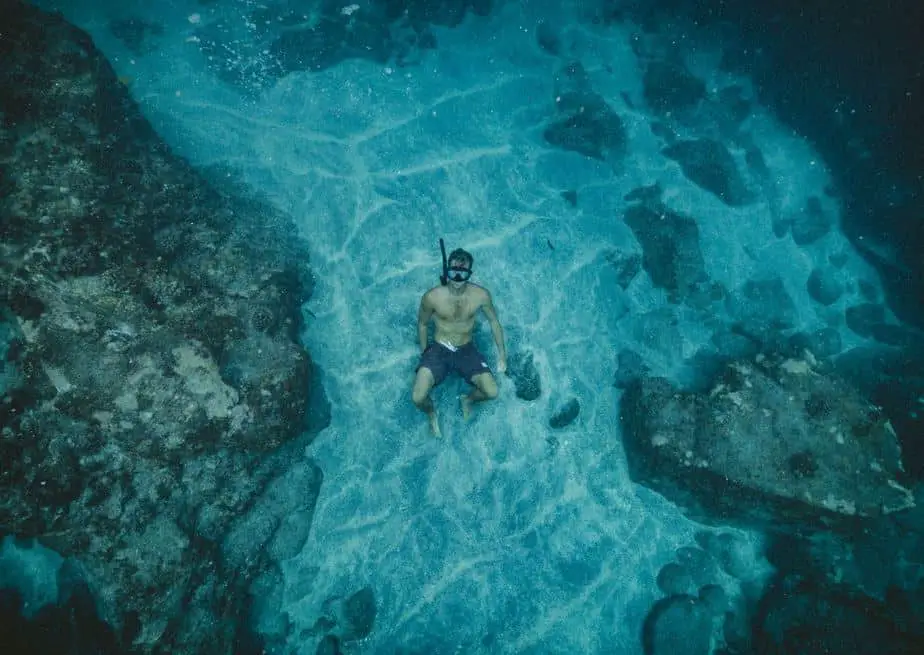Snorkeling is done by floating along the water’s surface, with face submerged, as one observes the underwater world while breathing through a snorkel. Snorkelers will often wear a flotation device to help them stay afloat and conserve their energy. If they are wearing a wetsuit and fins and snorkeling in saltwater, then it’s even easier to stay afloat.
Therefore, snorkeling can be done in deep water and shallow water. As long as the snorkeler is able to stay afloat, then they do not have to worry about the depth of the water. Whether the depth is 3 feet deep or 300 feet deep makes no difference to a snorkeler since they spend most of their time floating at the surface anyways. Generally speaking, most snorkelers will start off in shallow water and eventually progress to snorkeling from a boat in deep water.
In this article, we’ll discuss the advantages and disadvantages of snorkeling in both shallow and deep water. There are some legitimate reasons why one would pick one over the other. Perhaps you can even alternate between the two, because there are benefits to shallow and deep snorkeling.
Common snorkeling depths
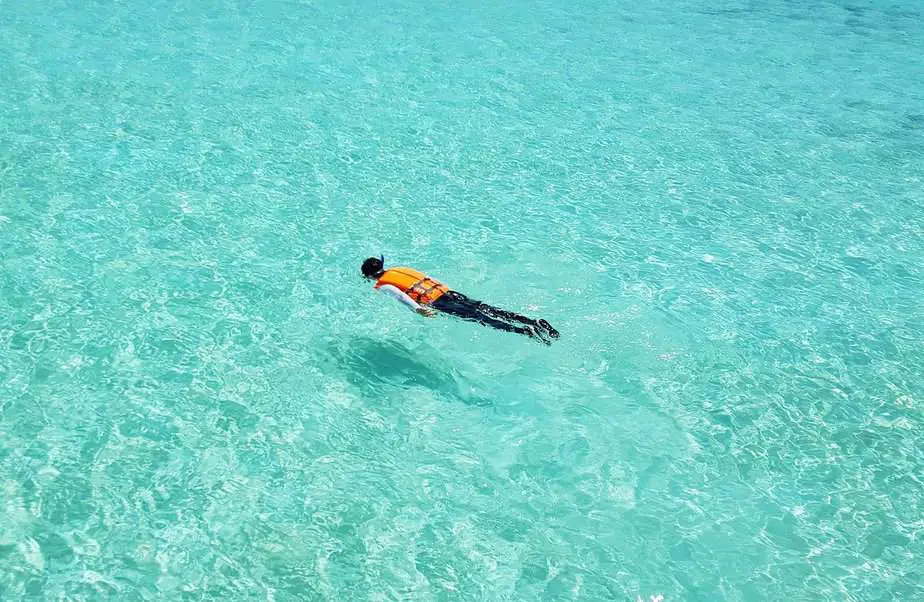
Most snorkeling is done between 3 – 10 m (10 – 30 ft) deep. This is a good depth for beginners to start at until they’ve gained enough confidence to dive in much deeper water.
Snorkeling is done at the surface of the water, it technically doesn’t really matter how deep the water is since you’ll be staying at the surface most of the time unless you’re also skin/duck diving.
Even at shallow depths, there’s much to see. In fact, most snorkelers prefer it if they can still see the ocean floor, which is why the most popular depth range for snorkelers is within 3 – 10 m. Snorkelers can see all the way to the bottom from the surface, and if they are skilled enough to do so, they can dive all the way down to get a closer look.
How deep can you snorkel?
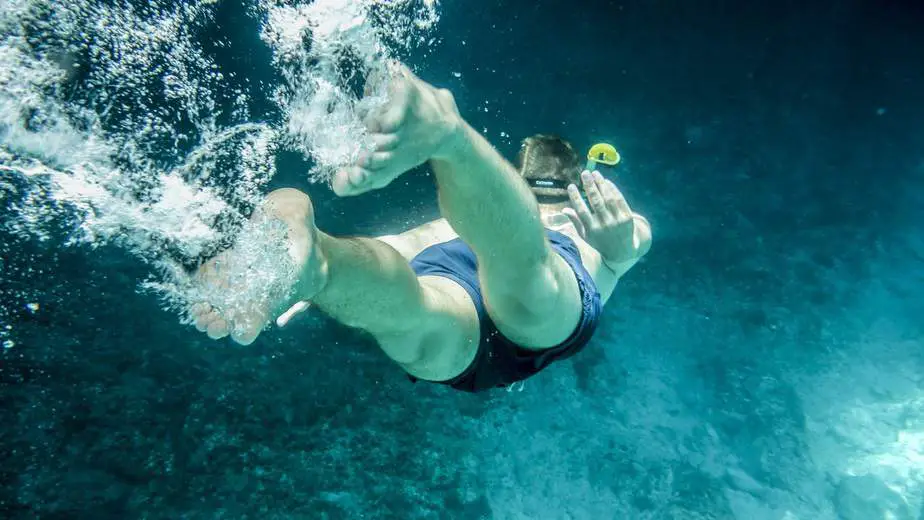
People commonly ask: why can’t snorkelers just use an extremely long snorkel so that they can snorkel deeper underwater? You’ll notice that most snorkels are around 1 – 1.5 feet long and no longer than that.
There are many good reasons why snorkelers should stay by the surface. The first major reason is that the longer the snorkel tube, the more force is required to inhale air. Your lungs would need to overcome a tremendous amount of water pressure at a depth of only 2-3 feet, which is why most snorkels are shorter than that.
The second major reason why snorkels aren’t very long (and why you can’t snorkel deep underwater) is that it would be difficult to completely clear the air out from the snorkel when you exhale. That means that there will be pockets of air in the tube where your exhaled carbon dioxide will linger. This will then mix with any fresh air you breathe, meaning you are actually re-inhaling some of the carbon dioxide.
Over time, you will find that you are getting dizzy and losing consciousness. The reason is that you aren’t getting enough oxygen because you keep inhaling carbon dioxide that wasn’t fully cleared from the tube. In effect, you are slowly asphyxiating from breathing all of this stale air.
Now, how come this isn’t a problem for scuba divers? Scuba divers use a special breathing apparatus called a regulator. The regulator takes the air from the tank and adjusts the pressure until it matches the surrounding pressure. Scuba divers are then able to easily and safely inhale this air.
When a diver exhales, the stale air is vented out into the water, and each time they inhale, they are getting fresh air. Thus, scuba divers can safely breathe underwater even at deep depths whereas snorkelers cannot. Snorkelers can only breathe underwater close to the surface because a long snorkel is impractical.
The only way for a snorkeler to go deep underwater is if they practice skin diving. Skin diving is when a snorkeler occasionally does a breath-hold dive, similar to what a freediver does, so that they can observe something up close. Once mastered, experienced skin divers can hold their breath down to 10 m (30 ft) and stay underwater for about a minute.
Snorkeling in waist deep water
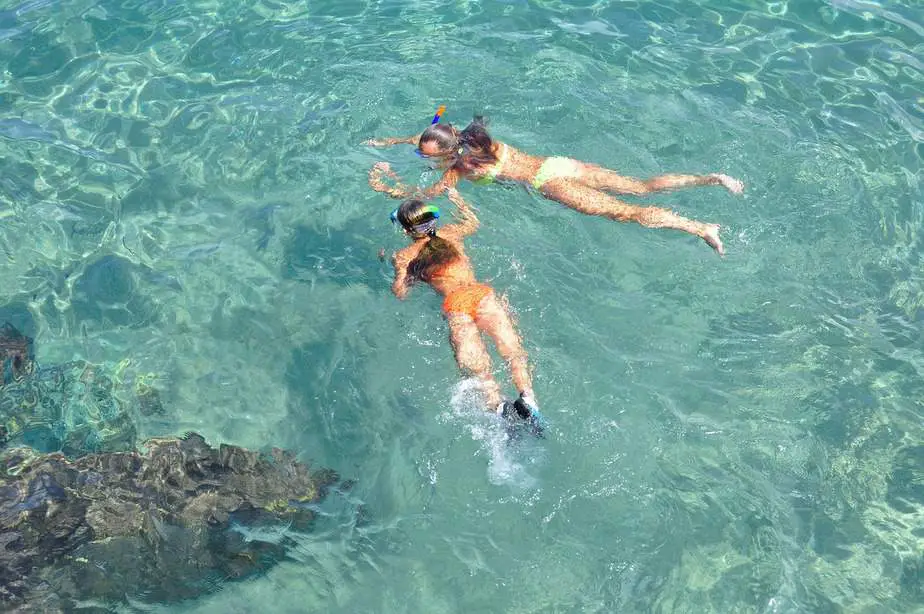
How shallow can you snorkel before it gets too shallow? You need at least 30 cm (1 ft) of depth just to accommodate your face, plus some additional distance so that you can move around and see things, so the minimum is probably around waist deep water (3 – 4 ft).
For many people, waist deep water is probably the best place to start snorkeling. When you’re just starting out, having a shallow bottom that you can stand up just in case is a great confidence builder. Make sure that the bottom is sandy so that you don’t do any damage to the aquatic life.
One issue of snorkeling in waist deep water is that there is a risk of standing on corals or other aquatic life. Even touching the coral or even kicking up sand on the coral can damage it. One of the most common ways corals have been getting damaged are from tourists who aren’t careful around them.
Coral bleaching is another issue which is when chemicals in the water are causing the corals to turn white in distress. This is often caused when snorkelers don’t wear reef-safe sunscreen. Please do your part in ocean reef conservation by being very careful in shallow water.
As your snorkeling skills improve and your confidence grows, then you can head into deeper water so that you have more room to kick your fins without worrying so much about damaging coral. By heading into water that is around 3 m (10 ft) deep, you can even stop and float vertically without hitting any coral.
The reason why we are stressing being careful around corals is not just for their protection, but for yours as well. They can easily cut and sting you through your fins and wetsuit if you accidentally hit it. You must be somewhat competent when snorkeling over them so as not to disturb them.
It’s possible to learn basic snorkeling techniques in waist deep water, however it may start to feel restrictive after a while. Furthermore, it should not be attempted if there is a strong current or swell. When the ocean is pulling you around, it’ll be difficult to avoid corals and rocks.
Try to learn the basics quickly so you can progress to slightly deeper water where you can snorkel in a more relaxed manner without worrying as much about hitting rocks or coral.
What is duck diving? How do you do it?
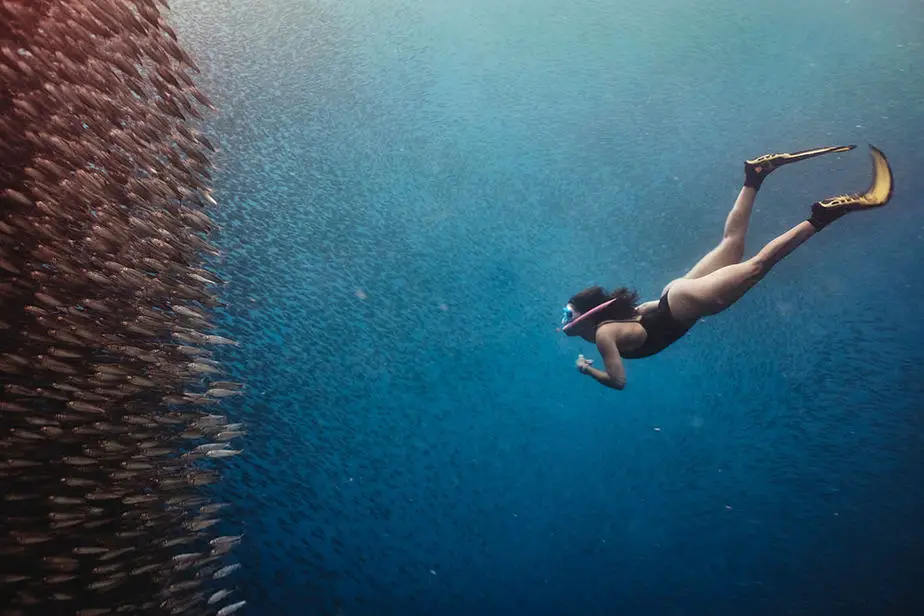
Duck diving or skin diving is when a snorkeler dives down from the surface while holding their breath so that they can get an up-close view of something underwater. Let’s be clear: snorkelers who duck dive are not breathing from their snorkel; they are doing a breath-hold dive much like what a freediver does. This is one way you can do some deep water snorkeling.
Now, as exciting as skin diving sounds, you should not do it until you’ve mastered the snorkeling basics. This is something that only experienced snorkelers should attempt, and they should have at least one other person at the surface to watch their backs.
The easiest, safest, and most legitimate way to learn about skin diving is to take one of the courses that a training agency offers. You will learn everything there is to know about snorkeling and skin diving, plus you will get a certification at the end of it. You don’t need to be certified to snorkel, but this is going above and beyond what you need.
Any of the following snorkeling courses are good:
- SSI offers their Snorkel Diver course.
- PADI offers their Skin Diver course.
- NAUI offers their Snorkeler course.
Taking an official course from PADI, SSI, NAUI, or any other dive training agency gives you access to a qualified instructor who will guide you through the basics. You will learn the proper techniques the right way.
Many self-taught snorkelers actually have bad technique that they ought to unlearn, and these courses are a great way to do that. You can also ask the instructor questions and ask for clarification if you’re confused.
Next, we’ll give you a crash course on how to skin dive. The purpose of this section is to give you an idea of what to expect. It is not a comprehensive resource and we cannot teach it better than a qualified instructor.
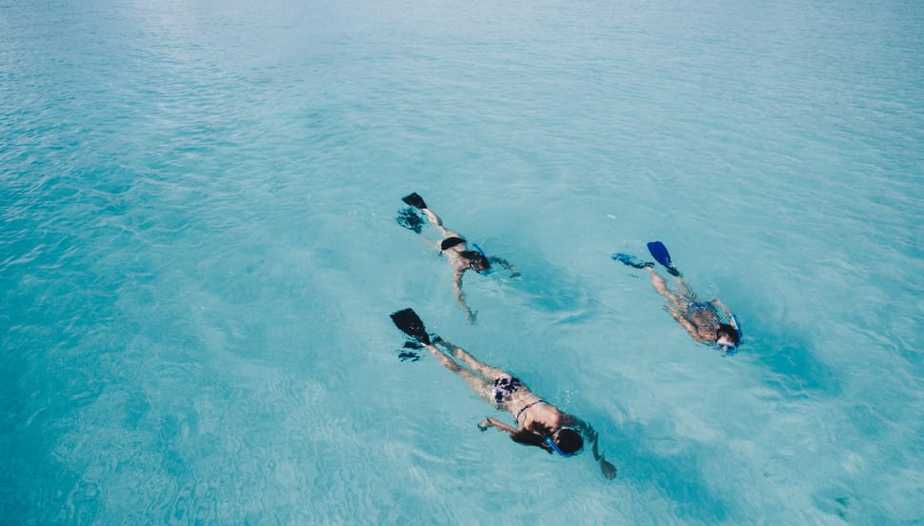
The basic skin diving steps are as follows:
- Check directly beneath you and determine if there is sufficient depth and there are no obstacles in the way.
- Take no more than three deep breaths prior to diving and hold the last breath. Any more than this and you risk hyperventilating which can cause shallow water blackouts.
- Get ready to dive. Pivot your body at the waist so your entire upper body is submerged underwater with your head pointing down.
- Starting kicking to propel yourself downwards.
- As you start to feel pressure building up in your mask and ears, equalize them to prevent mask squeeze and ear barotrauma. You can do this by exhaling through your nose to equalize your mask. Then pinch your nose and gently attempt to exhale through it to clear your ears.
- You should leave some air for your ascent. Don’t wait until you’re almost out of air to ascend because you never know if something might obstruct you on the way back up.
- Look up and raise your arm over your head to protect it before ascending.
- Once you reach the surface, clear your snorkel and inhale gently.
- If you’re diving with a buddy, only one of you should duck dive at a time. The other should remain waiting by the surface in case something happens to the first diver.
Equalizing is a common problem that beginner skin divers struggle with at first. Since skin divers do not dive as deep as scuba divers, some don’t even bother equalizing because the pressure is not severe enough to cause them injuries. However, depending on how deep the skin diver reaches, the pain may become unbearable.
The scuba diving adage “equalize early and often” applies here. You should be equalizing before it feels uncomfortable. Do not try to endure the pain; you’ll just end up with facial and ear barotrauma.
If you are trying to equalize but failing to do so for whatever reason, stop diving and head back to the surface.
How long can you stay underwater snorkeling?
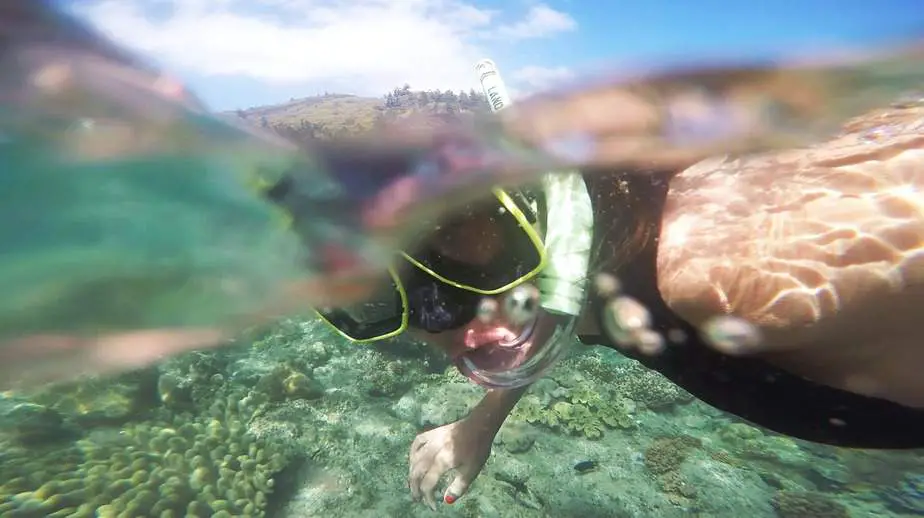
How long you can dive depends on how good you are at breath-hold dives and conserving your energy. It’s not unreasonable for a snorkeler to dive underwater for up to a minute and reach depths of 30 ft (10 m) with some practice.
To get better at duck diving, you can follow the same tips that freedivers utilize in order to increase their breath-hold time. The basics are exactly the same: stay relaxed and try not to have any wasted movements. For instance, it’s generally not recommended to use your hands to propel yourself due to how inefficient they are compared to kicking while wearing fins.
You might even want to learn how to do hands-free equalization so you don’t waste any movements pinching your nose to equalize your ears. To be fair, these tips are not strictly necessary, but if you are a diving enthusiast, then they are something you can strive to learn.
Can you get decompression sickness from duck diving?
Technically yes, but in practice, you don’t have to worry about getting decompression sickness from skin diving. It’s a concern for scuba divers because they spend much longer underwater at deeper depths where the water pressure is greater.
In the same way that freedivers are less susceptible to decompression sickness, a skin diver is even less likely because their goal is not to dive as deep as possible, but rather to explore the beautiful sights underwater.
Thus, skin divers do not spend enough time underwater nor do they dive deep enough for decompression sickness to be a concern. Plus, skin divers can simply increase their surface intervals between dives to further allow their body to off-gas.
Benefits of deep water snorkeling
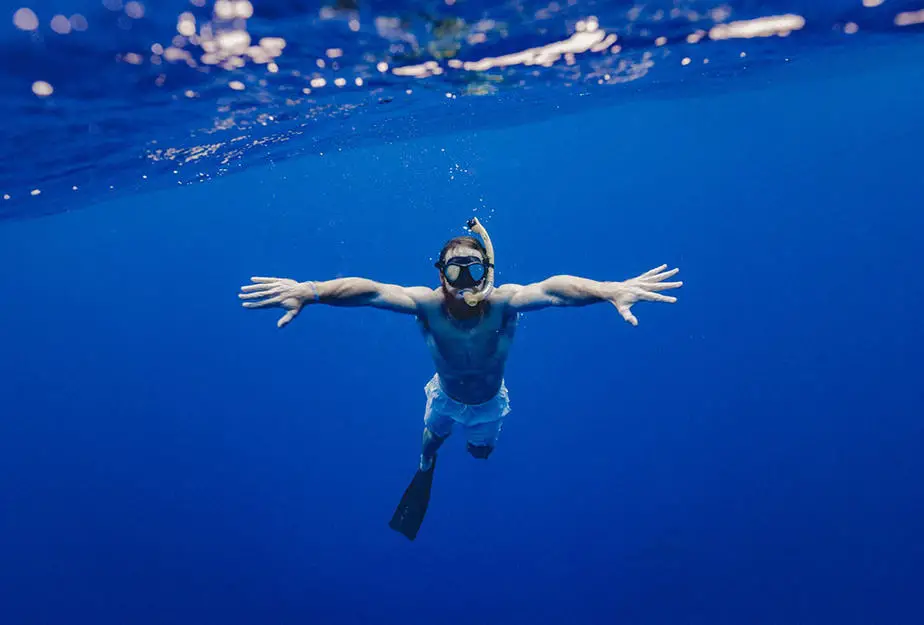
There are many benefits to deep water snorkeling. First, you are more likely to encounter a larger variety of fish and bigger marine life such as manta rays or sea turtles in deeper water.
Second, you can get a more panoramic view of the underwater world when snorkeling in deep water. If the water is clear enough, you can literally see over a hundred feet in all directions.
Third, when you snorkel in deep water, you now have the option to skin dive for a change in perspective. It’s also more exciting and enjoyable to see things up close.
Lastly, deep water snorkeling gives you more freedom to move around without worrying about damaging corals. You still have to pay attention to what’s beneath you or to your side such as a reef wall, however it’s otherwise quite liberating.
Downsides of deep water snorkeling
It’s not all rainbows and sunshine, there are some downsides to deep water snorkeling. First, the deeper the water is, the more color gets lost at deeper depths. Do you ever notice that most underwater photos are extremely blue?
If you’re bringing an underwater camera with you while snorkeling, then you need to consider how deep you want to go for the best photos. The best photos are taken at shallow depths.
Speaking of depth, there’s a greater risk of losing items that have detached or fallen out of your hand. Unless you catch it in time, it will sink to the depths, lost to the ocean.
Lastly, deep water is out in the open where the snorkeler can be susceptible to the ever-changing currents. It’s possible for you to feel nauseous due to the up and down motion of the waves. If this is the case for you, and you don’t want to end up vomiting, then you should stick to shallow waters.
Benefits of shallow water snorkeling
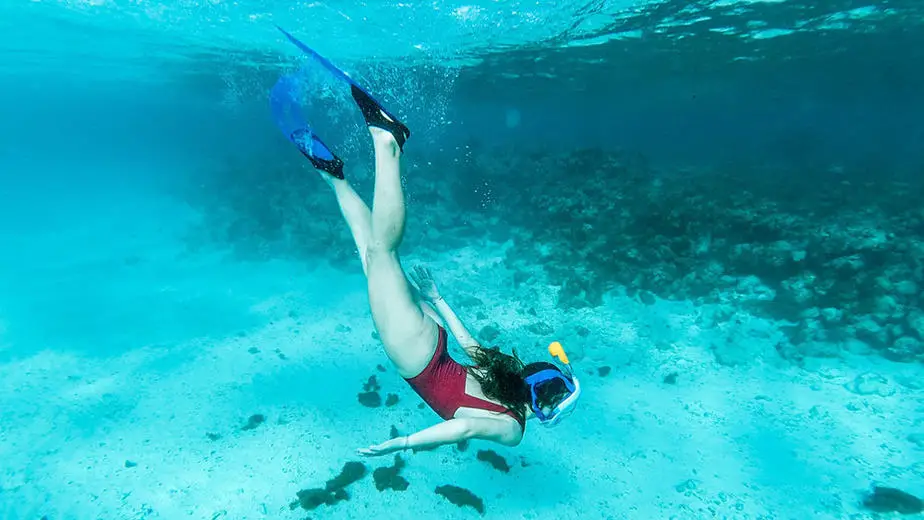
While deep water snorkeling has its benefits, shallow water snorkeling can be underrated sometimes. The first benefit is the most obvious: it’s much safer to snorkel in shallow waters because you can more easily reach the surface. In the case of waist deep snorkeling, you can just stand up.
Next, when you’re in shallow water, everything is already so close to you. You don’t have to do a breath-hold dive to get that up close view. At these shallow depths, the colors will still be vibrant and true to their original hue. It makes for some amazing underwater photos and you don’t have to worry about dropping your camera at these shallow depths.
In a similar vein, shallow water can make for some of the most relaxed snorkeling experiences because there’s no pressure to stay afloat. You can have peace of mind knowing that you can stand up at any time, and you can even drop things with little to no consequence.
Lastly, if you suffer from motion sickness due to the undulating waves, this becomes less of an issue in shallow water. Many shallow water sites are located at bays or lagoons where they are naturally protected. The waters there will be calm and pristine, allowing you to snorkel without getting vertigo.
Downsides of shallow water snorkeling
The major issues with shallow water snorkeling are that you don’t have much space to work with. If there are corals or other delicate marine life beneath or around you, it’s very easy to accidentally hit them.
Ironically, it actually takes great skill to avoid the plants and animals around you in shallow water. Coming into contact with them can not only hurt them, but can also hurt the snorkeler. Corals can inflict very painful stings that feel like you are badly burnt.
Next, since snorkelers are so close to the bottom in shallow water, it can be difficult not to disturb the sand. When the sand is kicked up, it drastically reduces visibility and can harm the corals. If you need to perfect your fin strokes, you should move to depths of 3 m (10 ft) to give yourself some space.
Additionally, shallow water is less visually interesting compared to deep water snorkeling. There’s less variety and almost no chance of seeing larger aquatic life. Even the smaller fishes will be less common.
Lastly, if the water is too shallow, then you do not have the option to skin dive. Skin diving is great fun and something we recommend all snorkelers try out at some point, and in order to do that, we recommend snorkeling in water that’s at least 5 m (15 ft) deep at minimum.
What kind of equipment do I need for deep water snorkeling?
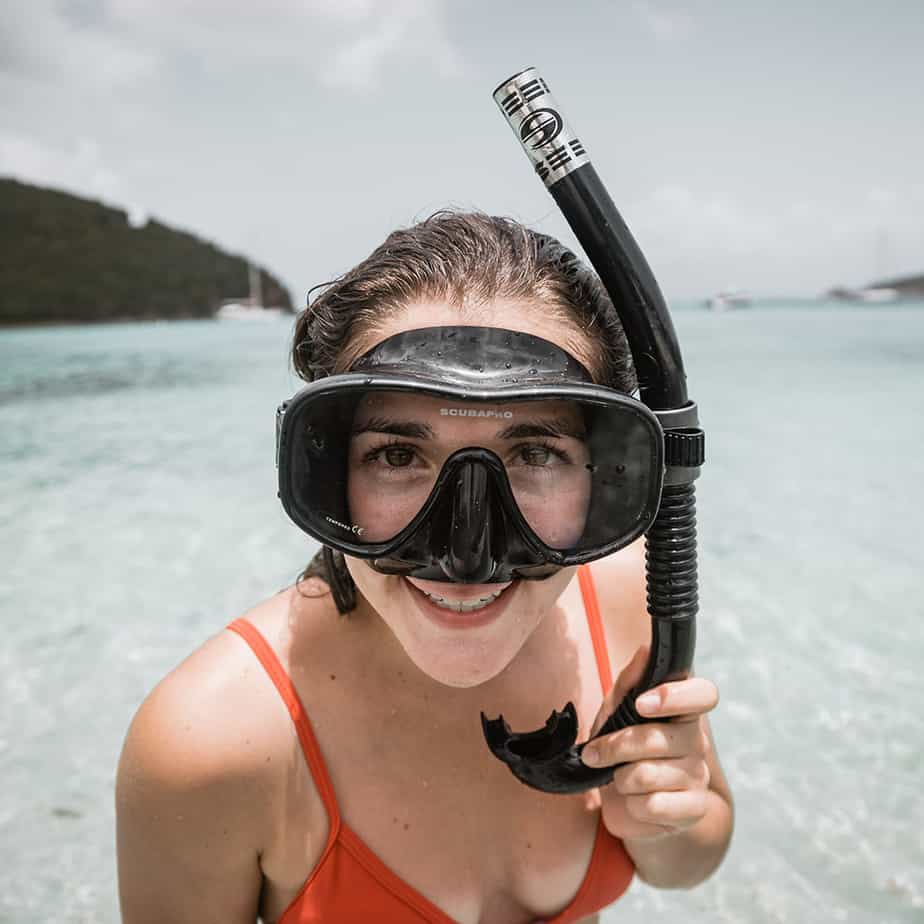
If you’re using a traditional mask and snorkel setup, then there’s no difference in equipment needed for shallow or deep water snorkeling. However, if you plan on duck diving, then people with full face masks will have difficulty diving.
The full face mask can trap a non-negligible amount of air inside. When you try to dive down, you will feel more resistance than usual because the air inside is positively buoyant and you will be fighting against it the whole time while diving.
Parting words
Snorkeling over deep water is a lot of fun. You can get a lot of great views, or even duck dive down to get a closer look at something interesting you’ve spotted. You also have a higher likelihood of seeing larger aquatic life like rays, turtles, or even dolphins.
Shallow water snorkeling also has its merits, particularly if you’re a non-swimmer or beginner snorkeler. Once you’ve learned the basics and gained confidence snorkeling in shallow water, you can move onto deep water snorkeling from a boat. Here, you can finally enjoy the spectacular views that the underwater world has to offer.

